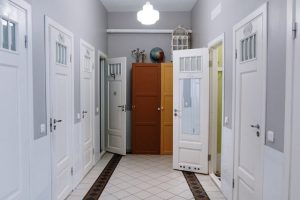
Have you ever considered just how much work your doors are doing to keep you at a comfortable temperature?
Probably not, but it turns out there are a lot of things you can do to help them out.
If you have interior doors that are falling apart, letting drafts in, or otherwise causing you to turn your boiler up, consider our tips for ensuring your doors are working as best as they can to make your home more energy efficient.
How interior Doors help regulate the room temperature
We’ll tackle the obvious way doors help your energy output: they conserve and release heat. Doors act as barriers between indoor conditioned air and unconditioned outdoor air. By closing doors, you prevent cooled or heated air from escaping, reducing energy waste. By opening them, hopefully, you allow colder or warmer air in. Simple.
What to consider in Doors to aid energy efficiency

However, there are a lot of ways in which closing a door to reserve the temperature in the room can go wrong. A door can let air escape and let the unwanted air outside in. For one thing, you’ll want to make sure that your door is made of quality wood and hasn’t warped over time, leaving gaps where air can escape. Insulated doors specifically help block the transfer of heat or cold.
Solid wood or metal doors allow more heat transfer than an insulated door. Upgrading can better seal in conditioned air. Find new quality doors at doorways.co.uk. If you want to be even more green about your doors, know that doors made from recycled materials like composite wood, plastic and fibreglass offer comparable insulation to wood but with ecological benefits.
Additionally, you might want to consider weatherstripping your doors. You can caulk or seal any cracks and openings in door frames to prevent unexpected air leaks from wasting indoor air. Just like how you would weatherstrip to stop air escaping out your windows, you can create an air-tight seal around your doors that keeps air leaks to a minimum. Make sure weatherstripping fits snugly without big gaps for air to pass through. Door sweeps placed along the bottom of doors block airflow near the floor gap can help this. They can reduce expensive energy loss from this overlooked area. Draft blocking behind open doors and under them will significantly control air leaks. Door snakes and brush-type products fit nicely to block gaps.
Plus, there are more tips and tricks you might not have thought about, such as the fact that double doors with an airlock entryway help insulate indoor temperatures even further compared to a single door. This is because the airlock traps air between both doors. Additionally, dark-coloured external doors absorb and retain more solar heat to transfer indoors during winter. Light colours reflect more sunlight keeping homes cooler in summer.
Even the direction in which a door opens can block or funnel breezes through the opening upon entry, impacting the temperature control. Even the hinge orientation matters.
Get SMART with your Doors

And then there are the tech advancements that can make sure your doors are closed, including smart tech. Every household has a kid, teenager, roommate, or forgetful parent who leaves every door open. SMART tech attached to your doors will ensure that any door that is not being used will be shut. You can get smart door timers which can prompt forgetful people to close them, or even attach a door closer like the ones in high street stores.
The spring-loaded device will slowly pull the door closed behind you. Or you can get an automatic door bottom, which seals the gap at the bottom of the door with a mechanical device that lowers when the door is open and raises to seal when the door closes. If you don’t like the corporate look of these devices, consider a self-closing door hinge, which has a spring built into it to close the door automatically.
Additionally, SMART tech can help you to keep the temperature where you want it without using too much money. Smart thermometers installed in your home or even your boiler can track the temperature of the room, turn off the heating when the room reaches a certain temperature and turn it back on when it drops below a certain threshold, keeping your home warm without overspending on your energy bills.
![]()
Author Profile

- Eco Warrior by day, Eco Blogger by night trying to get the eco balance right.
Latest entries
 Green Home GuidesApril 17, 2025How Heat Pumps Help Cut Household Carbon Emissions
Green Home GuidesApril 17, 2025How Heat Pumps Help Cut Household Carbon Emissions EnvironmentApril 17, 20256 Benefits of Wall Cladding for Eco-Friendly Renovations
EnvironmentApril 17, 20256 Benefits of Wall Cladding for Eco-Friendly Renovations EnvironmentMarch 31, 20255 Sustainable Materials for Building Your Dream Eco-Friendly Pergola
EnvironmentMarch 31, 20255 Sustainable Materials for Building Your Dream Eco-Friendly Pergola Best practicesMarch 25, 202510 Green Tips to Live a More Sustainable Lifestyle
Best practicesMarch 25, 202510 Green Tips to Live a More Sustainable Lifestyle





Leave a Reply
You must be logged in to post a comment.